The global high molecular ammonium polyphosphate market is valued at USD 580.9 million in 2025 and is set to reach USD 835.4 million by 2035, growing at a CAGR of 3.7%. The high molecular ammonium polyphosphate market stands at the forefront of a transformative decade that promises to redefine flame retardancy infrastructure and fire protection excellence across rubber, plastic, fiber, wood, and industrial sectors. The market's journey from USD 580.9 million in 2025 to USD 835.4 million by 2035 represents substantial growth, demonstrating the accelerating adoption of advanced phosphorus-based solutions and sophisticated flame-retardant systems across polymer applications, construction materials, textile processing, and chemical manufacturing operations.
The first half of the decade (2025-2030) will witness the high molecular ammonium polyphosphate market climbing from USD 580.9 million to approximately USD 698.2 million, adding USD 117.3 million in value, which constitutes 46% of the total forecast growth period. This phase will be characterized by the rapid adoption of high-phosphorus content systems, driven by increasing demand for enhanced fire safety barriers and superior thermal stability requirements worldwide. Advanced char formation and smoke suppression features will become standard expectations rather than premium options.
The latter half (2030-2035) will witness sustained growth from USD 698.2 million to USD 835.4 million, representing an addition of USD 137.2 million or 54% of the decade's expansion. This period will be defined by mass market penetration of specialized multi-grade systems, integration with comprehensive fire safety platforms, and seamless compatibility with existing polymer processing and manufacturing infrastructure. The high molecular ammonium polyphosphate market trajectory signals fundamental shifts in how manufacturers and chemical companies approach flame retardancy solutions, with participants positioned to benefit from sustained demand across multiple application segments.
The high molecular ammonium polyphosphate market demonstrates distinct growth phases with varying market characteristics and competitive dynamics. Between 2025 and 2030, the high molecular ammonium polyphosphate market progresses through its advanced phosphorus adoption phase, expanding from USD 580.9 million to USD 698.2 million with steady annual increments averaging 3.8% growth. This period showcases the transition from basic ammonium polyphosphate systems to advanced high-molecular-weight formats with enhanced thermal stability and integrated char-forming becoming mainstream features.
The 2025-2030 phase adds USD 117.3 million to market value, representing 46% of total decade expansion. Market maturation factors include standardization of phosphorus content specifications, declining material costs for high-performance flame retardants, and increasing manufacturer awareness of premium additive benefits reaching 75-80% effectiveness in fire protection applications. Competitive landscape evolution during this period features established manufacturers like Clariant and ICL expanding their product portfolios while new entrants focus on specialized eco-friendly solutions and enhanced thermal decomposition technology.
From 2030 to 2035, market dynamics shift toward advanced customization and multi-sector deployment, with growth accelerating from USD 698.2 million to USD 835.4 million, adding USD 137.2 million or 54% of total expansion. This phase transition logic centers on universal high-performance systems, integration with automated polymer processing equipment, and deployment across diverse application scenarios, becoming standard rather than specialized flame retardant formats. The competitive environment matures with focus shifting from basic phosphorus content to comprehensive thermal performance and compatibility with modern polymer processing operations.
| Metric | Value |
|---|---|
| Market Value (2025) | USD 580.9 million |
| Market Forecast (2035) | USD 835.4 million |
| Growth Rate | 3.7% CAGR |
| Leading Phosphorus Content Type | ≥30% |
| Primary Application | Rubber Segment |
The high molecular ammonium polyphosphate market demonstrates strong fundamentals with high-phosphorus content systems capturing a dominant share through superior flame retardancy characteristics and cost-effective manufacturing capabilities. Rubber applications drive primary demand, supported by increasing automotive component requirements and enhanced fire protection management solutions. Geographic expansion remains concentrated in developed markets with established chemical processing infrastructure, while emerging economies show accelerating adoption rates driven by industrialization projects and rising fire safety awareness activity.
Market expansion rests on three fundamental shifts driving adoption across industrial and manufacturing sectors. Fire safety regulations create compelling advantages through ammonium polyphosphate systems that provide comprehensive flame retardancy with standardized processing compatibility, enabling manufacturers to meet increasing safety requirements and maintain regulatory standards while ensuring efficient production operations and justifying investment over basic flame retardant methods. Industrial facility modernization accelerates as companies worldwide seek reliable fire protection systems that deliver operational safety directly to daily operations, enabling risk reduction that aligns with facility management expectations and maximizes processing productivity. Manufacturing demand increases drive adoption from polymer processors requiring advanced flame retardants that maximize thermal protection while maintaining processing performance during compounding and molding operations.
However, growth faces headwinds from raw material price variations that differ across phosphorus suppliers regarding cost stability and supply chain reliability, potentially limiting margin consistency in price-sensitive industrial categories. Environmental compliance also persists regarding processing regulations and emission requirements that may increase complexity standards in markets with demanding chemical processing protocols.
The high molecular ammonium polyphosphate market represents a compelling intersection of flame retardancy innovation, phosphorus chemistry advancement, and fire protection optimization management. With robust growth projected from USD 580.9 million in 2025 to USD 835.4 million by 2035 at a 3.7% CAGR, this market is driven by increasing fire safety expansion trends, industrial processing requirements, and manufacturing demand for reliable flame retardant formats.
The high molecular ammonium polyphosphate market's expansion reflects a fundamental shift in how polymer manufacturers and chemical processors approach fire protection infrastructure. Strong growth opportunities exist across diverse applications, from rubber operations requiring automotive-grade flame retardancy to plastic facilities demanding high-performance solutions. Geographic expansion is particularly pronounced in Asia-Pacific markets, led by China (5% CAGR) and India (4.6% CAGR), while established markets in North America and Europe drive innovation and specialized segment development.
The dominance of high-phosphorus content systems and rubber applications underscores the importance of proven phosphorus chemistry and thermal reliability in driving adoption. Molecular weight and processing complexity remain key challenges, creating opportunities for companies that can deliver consistent performance while maintaining cost efficiency.
Primary Classification: The market segments by phosphorus content into ≥30% and <30% categories, representing the evolution from standard phosphorus formulations to advanced high-concentration formats for comprehensive flame retardancy operations.
Secondary Breakdown: Application segmentation divides the high molecular ammonium polyphosphate market into rubber, plastic, fiber, wood, and other sectors, reflecting distinct requirements for thermal stability, processing compatibility, and flame retardancy performance.
Regional Classification: Geographic distribution covers Asia Pacific, North America, Europe, Latin America, and the Middle East & Africa, with developed markets leading innovation while emerging economies show accelerating growth patterns driven by industrial development programs.
The segmentation structure reveals technology progression from standard phosphorus content toward integrated high-concentration platforms with enhanced thermal and processing capabilities, while application diversity spans from rubber operations to wood processing requiring comprehensive flame retardancy and thermal protection solutions.
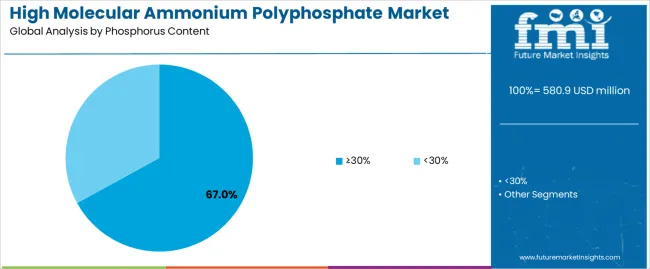
The ≥30% phosphorus content segment is estimated to account for 67% of the high molecular ammonium polyphosphate market share in 2025. The segment's leading position stems from its fundamental role as a critical component in flame retardancy applications and its extensive use across multiple industrial and manufacturing sectors. High phosphorus content's dominance is attributed to its superior flame retardancy efficiency, including excellent char formation, reliable thermal decomposition, and balanced cost-effectiveness that make it indispensable for demanding fire protection operations.
Market Position: High phosphorus content systems command the leading position in the high molecular ammonium polyphosphate market through advanced synthesis technologies, including comprehensive purity control, uniform molecular weight distribution, and reliable manufacturing performance that enable producers to deploy flame retardant solutions across diverse application environments.
Value Drivers: The segment benefits from manufacturer preference for proven phosphorus profiles that provide exceptional fire protection without requiring premium material costs. Efficient synthesis processes enable deployment in rubber compounds, plastic formulations, and industrial applications where thermal reliability and cost efficiency represent critical selection requirements.
Competitive Advantages: High phosphorus content systems differentiate through excellent flame retardancy performance, proven thermal stability, and compatibility with standard processing equipment that enhance fire protection capabilities while maintaining economical material profiles suitable for diverse industrial applications.
Key market characteristics:
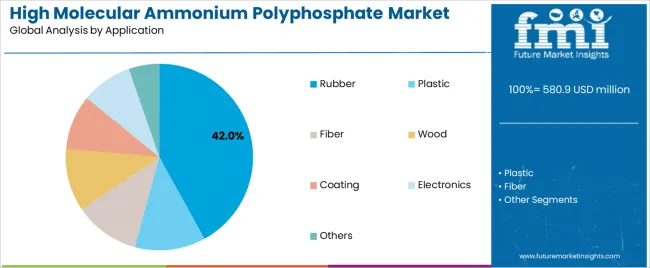
The rubber segment is projected to hold 42% of the high molecular ammonium polyphosphate market share in 2025. The segment's market leadership is driven by the extensive use of flame retardants in automotive components, industrial seals, cable applications, and general rubber manufacturing, where phosphorus compounds serve as both a fire protection barrier and processing additive. The rubber sector's consistent demand for reliable flame retardants supports the segment's dominant position.
Market Context: Rubber applications dominate the high molecular ammonium polyphosphate market due to widespread adoption of fire safety solutions and increasing focus on automotive safety, cable protection, and industrial fire prevention that enhance operational safety while maintaining performance standards.
Appeal Factors: Rubber manufacturers prioritize thermal stability, processing compatibility, and integration with standard vulcanization systems that enable coordinated deployment across multiple production needs. The segment benefits from substantial automotive growth and industrial development that emphasize reliable fire protection systems for rubber applications.
Growth Drivers: Automotive safety regulations incorporate flame retardants as standard components for vehicle components and cable systems. At the same time, industrial safety initiatives are increasing demand for premium features that comply with fire protection standards and enhance processing performance.
Market Challenges: Raw material cost fluctuations and processing standardization may limit deployment flexibility in ultra-price-sensitive markets or regions with varying safety requirements.
Application dynamics include:
Growth Accelerators: Industrial expansion drives primary adoption as ammonium polyphosphate systems provide exceptional flame retardancy capabilities that enable fire protection without processing failure, supporting safety improvement and manufacturing efficiency that require reliable phosphorus formats. Fire safety regulations accelerate market expansion as manufacturers seek advanced flame retardants that maintain processing performance during compounding while enhancing fire protection through standardized grades and compatibility. Manufacturer awareness increases worldwide, creating sustained demand for thermal stability systems that complement production routines and provide operational advantages in processing efficiency.
Growth Inhibitors: Raw material volatility challenges differ across phosphorus markets regarding price stability and supply chain consistency, which may limit margin predictability and cost planning in price-sensitive industrial categories with demanding affordability requirements. Regulatory complexity persists regarding processing standards and environmental compliance that may increase manufacturing costs in jurisdictions with strict chemical processing protocols. Market fragmentation across multiple grade specifications and molecular weight standards creates compatibility concerns between different processing systems and existing manufacturing infrastructure.
Market Evolution Patterns: Adoption accelerates in industrial and manufacturing sectors where fire safety benefits justify material investments, with geographic concentration in developed markets transitioning toward mainstream adoption in emerging economies driven by industrialization and fire safety development. Technology advancement focuses on enhanced molecular properties, improved processing efficiency, and integration with automated compounding systems that optimize flame retardancy performance and production consistency. The high molecular ammonium polyphosphate market could face disruption if alternative flame retardant methods or regulatory changes significantly challenge traditional ammonium polyphosphate advantages in fire protection applications.
The high molecular ammonium polyphosphate market demonstrates varied regional dynamics with growth leaders including China (5% CAGR) and India (4.6% CAGR) driving expansion through industrial growth and fire safety modernization. Steady Performers encompass Germany (4.3% CAGR), Brazil (3.9% CAGR), the USA (3.5% CAGR), the UK (3.1% CAGR), and Japan (2.8% CAGR), benefiting from established chemical processing systems and premium product adoption.
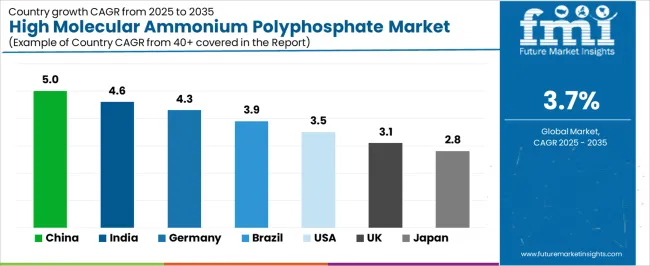
| Country | CAGR (2025-2035) |
|---|---|
| China | 5% |
| India | 4.6% |
| Germany | 4.3% |
| Brazil | 3.9% |
| USA | 3.5% |
| UK | 3.1% |
| Japan | 2.8% |
Regional synthesis reveals Asia-Pacific markets leading growth through industrial expansion and fire safety development, while European countries maintain steady expansion supported by specialized applications and environmental compliance requirements. North American markets show moderate growth driven by automotive demand and industrial facility upgrades.
China establishes regional leadership through rapid industrial development and comprehensive fire safety modernization, integrating advanced ammonium polyphosphate systems as standard components in automotive manufacturing and polymer processing operations. The country's 5% CAGR through 2035 reflects industrial growth promoting manufacturing density and chemical infrastructure development that mandate the use of reliable flame retardant systems in processing operations. Growth concentrates in major industrial centers, including Guangdong, Jiangsu, and Shandong, where manufacturing networks showcase integrated flame retardant systems that appeal to chemical companies seeking enhanced processing efficiency and international fire safety standards.
Chinese manufacturers are developing innovative ammonium polyphosphate solutions that combine local production advantages with international quality specifications, including high-molecular-weight systems and advanced thermal stability capabilities.
Strategic Market Indicators:
The Indian market emphasizes chemical processing applications, including rapid industrial development and comprehensive manufacturing expansion that increasingly incorporates ammonium polyphosphate for automotive components and polymer applications. The country is projected to show a 4.6% CAGR through 2035, driven by massive industrialization activity under manufacturing initiatives and chemical demand for standardized, high-quality flame retardant systems. Indian processing facilities prioritize cost-effectiveness with ammonium polyphosphate delivering operational efficiency through economical material usage and reliable performance capabilities.
Technology deployment channels include major chemical manufacturers, automotive companies, and polymer processors that support high-volume usage for domestic and industrial applications.
Performance Metrics:
In North Rhine-Westphalia, Bavaria, and Baden-Württemberg, German chemical facilities and automotive manufacturers are implementing advanced ammonium polyphosphate systems to enhance processing capabilities and support operational efficiency that aligns with environmental protocols and safety standards. The German market demonstrates sustained growth with a 4.3% CAGR through 2035, driven by automotive safety programs and industrial investments that emphasize reliable flame retardant systems for automotive and polymer applications. German processing facilities are prioritizing ammonium polyphosphate systems that provide exceptional thermal properties while maintaining compliance with environmental standards and minimizing processing complexity, particularly important in automotive manufacturing and chemical processing operations.
Market expansion benefits from automotive programs that mandate enhanced fire protection in safety specifications, creating sustained demand across Germany's automotive and chemical sectors, where thermal stability and material consistency represent critical requirements.
Strategic Market Indicators:
Brazil's developing chemical market demonstrates strategic ammonium polyphosphate deployment, growing at 3.9% CAGR, with documented operational excellence in automotive applications and polymer processing through integration with existing manufacturing systems and quality assurance infrastructure. The country leverages industrial expertise in chemical manufacturing and polymer processing to maintain market growth. Industrial centers, including São Paulo, Rio de Janeiro, and Minas Gerais, showcase advanced installations where ammonium polyphosphate systems integrate with comprehensive processing platforms and manufacturing systems to optimize fire protection and operational efficiency.
Brazilian processing facilities prioritize cost efficiency and performance consistency in product selection, creating demand for reliable ammonium polyphosphate systems with advanced features, including high thermal stability and integration with automated processing protocols. The high molecular ammonium polyphosphate market benefits from established chemical infrastructure and willingness to invest in specialized flame retardant technologies that provide superior fire protection and regulatory compliance.
Market Intelligence Brief:
The USA market emphasizes advanced ammonium polyphosphate features, including innovative molecular technologies and integration with comprehensive fire safety platforms that manage automotive processing, industrial operations, and chemical applications through unified flame retardant systems. The country is projected to show a 3.5% CAGR through 2035, driven by automotive expansion under electric vehicle development trends and industrial demand for premium, reliable flame retardant systems. American manufacturers prioritize performance with ammonium polyphosphate delivering comprehensive fire protection through enhanced thermal stability and processing innovation.
Technology deployment channels include major chemical companies, automotive manufacturers, and industrial processors that support custom development for premium operations.
Performance Metrics:
The UK market emphasizes regulatory compliance applications, including comprehensive automotive development and specialized chemical processing that increasingly incorporates ammonium polyphosphate for vehicle components and industrial applications. The country is projected to show a 3.1% CAGR through 2035, driven by automotive safety initiatives and chemical investments that emphasize reliable flame retardant systems for automotive and processing applications. UK facilities prioritize regulatory compliance with ammonium polyphosphate delivering operational efficiency through proven material performance and reliable safety capabilities.
Technology deployment channels include automotive manufacturers, chemical processors, and industrial facilities that support specialized development for compliance operations.
Performance Metrics:
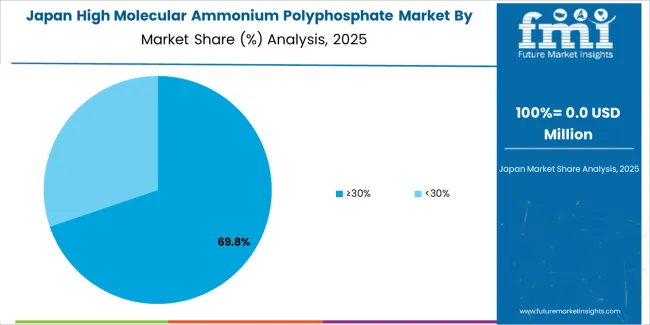
Japan's sophisticated chemical market demonstrates meticulous ammonium polyphosphate deployment, growing at 2.8% CAGR, with documented operational excellence in automotive applications and polymer processing through integration with existing manufacturing systems and quality assurance infrastructure. The country leverages engineering expertise in chemical manufacturing and polymer processing to maintain market leadership. Industrial centers, including Tokyo, Osaka, and Nagoya, showcase advanced installations where ammonium polyphosphate systems integrate with comprehensive processing platforms and manufacturing systems to optimize fire protection and operational efficiency.
Japanese processing facilities prioritize thermal precision and material consistency in product selection, creating demand for premium ammonium polyphosphate systems with advanced features, including ultra-high molecular weights and integration with automated processing protocols. The high molecular ammonium polyphosphate market benefits from established chemical infrastructure and willingness to invest in specialized flame retardant technologies that provide superior thermal properties and regulatory compliance.
Market Intelligence Brief:
The high molecular ammonium polyphosphate market in Europe is projected to grow from USD 142.6 million in 2025 to USD 198.7 million by 2035, registering a CAGR of 3.4% over the forecast period. Germany is expected to maintain its leadership position with a 38.2% market share in 2025, declining slightly to 37.8% by 2035, supported by its chemical processing excellence and major manufacturing centers, including North Rhine-Westphalia and Bavaria.
France follows with a 22.1% share in 2025, projected to reach 22.7% by 2035, driven by comprehensive automotive programs and industrial facility initiatives. The United Kingdom holds a 16.3% share in 2025, expected to maintain 16.8% by 2035 through established automotive sectors and chemical processing adoption. Italy commands a 13.7% share, while Spain accounts for 6.4% in 2025. The Rest of Europe region is anticipated to gain momentum, expanding its collective share from 3.3% to 4.2% by 2035, attributed to increasing industrial development in Eastern European countries and emerging chemical processing programs implementing standardized flame retardant systems.
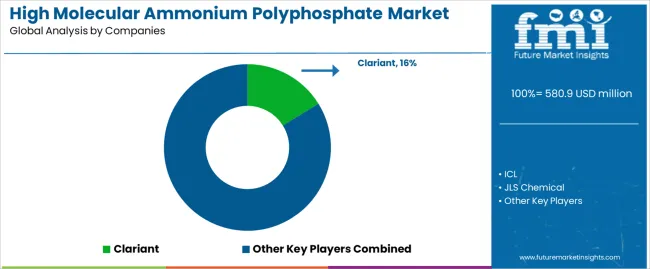
The high molecular ammonium polyphosphate market operates with moderate concentration, featuring approximately 15-22 participants, where leading companies control roughly 45-52% of the global market share through established distribution networks and comprehensive product portfolio capabilities. Competition emphasizes thermal performance, processing consistency, and cost efficiency rather than premium feature rivalry.
Market leaders encompass Clariant, ICL, and JLS Chemical, which maintain competitive advantages through extensive phosphorus chemistry expertise, global distribution networks, and comprehensive technical support capabilities that create manufacturer loyalty and support industrial requirements. These companies leverage decades of flame retardant production experience and ongoing molecular technology investments to develop advanced ammonium polyphosphate systems with exceptional thermal stability and processing features.
Specialty challengers include XUSEN, Weidong Chemical Industry, and Oceanchem Group, which compete through specialized application innovation focus and efficient manufacturing solutions that appeal to industrial buyers seeking reliable performance formats and custom grade flexibility. These companies differentiate through operational efficiency emphasis and specialized market focus.
Market dynamics favor participants that combine consistent thermal performance with advanced processing support, including automated dosing and distribution capabilities. Competitive pressure intensifies as traditional chemical manufacturers expand into flame retardant systems. At the same time, specialized additive producers challenge established players through innovative phosphorus formulations and cost-effective production targeting emerging industrial segments.
| Item | Value |
|---|---|
| Quantitative Units | USD 580.9 million |
| Phosphorus Content | ≥30%, <30% |
| Application | Rubber, Plastic, Fiber, Wood, Coating, Electronics, Others |
| Regions Covered | Asia Pacific, North America, Europe, Latin America, Middle East & Africa |
| Countries Covered | China, India, Germany, Brazil, USA, UK, Japan, and 25+ additional countries |
| Key Companies Profiled | Clariant, ICL, JLS Chemical, XUSEN, Weidong Chemical Industry, Oceanchem Group |
| Additional Attributes | Dollar sales by phosphorus content and application categories, regional adoption trends across Asia Pacific, North America, and Europe, competitive landscape with chemical manufacturers and flame retardant producers, industrial preferences for thermal characteristics and processing performance, integration with polymer processing equipment and manufacturing systems, innovations in molecular synthesis technology and high-phosphorus systems, and development of specialized flame retardant solutions with enhanced thermal stability and processing compatibility features |
The global high molecular ammonium polyphosphate market is estimated to be valued at USD 580.9 million in 2025.
The market size for the high molecular ammonium polyphosphate market is projected to reach USD 835.4 million by 2035.
The high molecular ammonium polyphosphate market is expected to grow at a 3.7% CAGR between 2025 and 2035.
The key product types in high molecular ammonium polyphosphate market are ≥30% and <30%.
In terms of application, rubber segment to command 42.0% share in the high molecular ammonium polyphosphate market in 2025.






Full Research Suite comprises of:
Market outlook & trends analysis
Interviews & case studies
Strategic recommendations
Vendor profiles & capabilities analysis
5-year forecasts
8 regions and 60+ country-level data splits
Market segment data splits
12 months of continuous data updates
DELIVERED AS:
PDF EXCEL ONLINE
High Mast Lighting Market Forecast and Outlook 2025 to 2035
High-Protein Pudding Market Forecast and Outlook 2025 to 2035
High Voltage Ceramic Zinc Oxide Surge Arrester Market Size and Share Forecast Outlook 2025 to 2035
High-Power Microwave Source Market Size and Share Forecast Outlook 2025 to 2035
High Performance Epoxy Coating Market Size and Share Forecast Outlook 2025 to 2035
High Temperature Fiberglass Filter Media Market Size and Share Forecast Outlook 2025 to 2035
High Performance Fluoropolymer Market Size and Share Forecast Outlook 2025 to 2035
High Throughput Screening Market Size and Share Forecast Outlook 2025 to 2035
High Barrier Packaging Films for Pharmaceuticals Market Size and Share Forecast Outlook 2025 to 2035
High Barrier Packaging Films Market Size and Share Forecast Outlook 2025 to 2035
High Purity Carbonyl Iron Powder (CIP) Market Size and Share Forecast Outlook 2025 to 2035
High Voltage PTC Heater Market Size and Share Forecast Outlook 2025 to 2035
High-Performance Fiber Market Size and Share Forecast Outlook 2025 to 2035
High Temperature Grease Market Size and Share Forecast Outlook 2025 to 2035
High Frequency Chest-Wall Oscillation Devices Market Size and Share Forecast Outlook 2025 to 2035
High-purity Fluoropolymer Valves Market Size and Share Forecast Outlook 2025 to 2035
High Barrier Pharmaceutical Packaging Films for Blister Market Size and Share Forecast Outlook 2025 to 2035
High Current Ion Implanter Market Size and Share Forecast Outlook 2025 to 2035
High Rate Discharge Test Machine Market Size and Share Forecast Outlook 2025 to 2035
High-precision Confocal Sensor Market Size and Share Forecast Outlook 2025 to 2035

Thank you!
You will receive an email from our Business Development Manager. Please be sure to check your SPAM/JUNK folder too.
Chat With
MaRIA